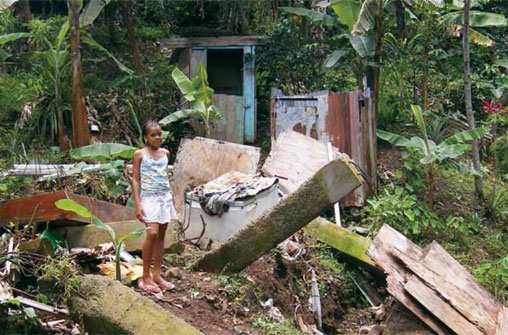STORY HIGHLIGHTS
- Informal hillside settlements in the Caribbean are highly vulnerable to landslides.
- A community based initiative has reduced this risk and improved residents’ lives.
- A new book has collated evidence and results so other at-risk communities can benefit from these successes./li>
Even a normal rainy day in Castries, the Saint Lucian capital, is a cause for concern for the city’s most vulnerable populations.
Surrounded by mountains, the steep slopes house the city’s rapidly growing informal hillside communities. With no proper drainage or infrastructure to deal with excess surface water, these communities are highly vulnerable to landslides triggered by even relatively light rainfall.
This risk is then exacerbated by the Caribbean’s natural weather patterns of heavy rain and frequent cyclones. The result: a loss of property, livelihood and, in the worst cases, lives. All of which, pose a very real threat for development and have the potential to reverse recent progress.
However, thanks to a new community-based approach, the Caribbean island of Saint Lucia is today a success story within the region for its efforts in managing the risk of rainfall-triggered landslides.
A new initiative, implemented with the help of the World Bank, has provided the Saint Lucian government with crucial information about the causes of landslides as well as an insight into the most at-risk areas.

A young girl stands outside a home destroyed by a rainfall-triggered landslide in Castries, Saint Lucia.
Addressing both the effects and causes of landslides, the Management of Slope Stability in Communities, or MoSSaiC, project reduced the risk with a three-pronged approach:
- Science-based: Physical causes are localized and appropriate measures designed to address these causes.
- Community-based: Residents are engaged in identifying causes and solutions. Additionally, community-based contractors and workers are employed to construct drainage solutions, increasing access to employment, education and training in the communities.
- Evidence-based: Rigorous and effective quality is maintained through training and design standards. Appropriate physical solutions are then delivered to reduce the landslide risk.
And it’s an approach that works. In October 2010, despite rainfall of 50 centimeters in just 24 hours, all of the hillside communities of Castries who had implemented the MoSSaiC program weathered the storm without landslides. Prior to the project, these same hillsides would have shown signs of instability during much lighter rainfalls.
"[During Hurricane Tomas] the water was as high and gushing as I had ever seen before. The timing of the drains being installed was so right, just before the storm, as no landslides occurred like they did before."
Eldrena St. Luce
Community Leader in Morne du Don, Castries
Learning from experience
Landslides occur in many areas in the world, with tropical, developing countries, such as those in the Eastern Caribbean, particularly at risk of rainfall-triggered slips.
Given the success of the MoSSaic project so far, a new book has now been published by the World Bank. The aim, to give other communities facing the same landslide risks the opportunity to implement the initiative’s techniques and strategies.
"MoSSaiC is innovative in its approach to engage all levels of community and government to create a coalition to address landslide risk. This approach is galvanizing long-term collaboration and providing opportunities to share this knowledge across the Caribbean region," explained Tiguist Fisseha, World Bank Disaster Risk Management Specialist.
Based on the experiences of the communities involved, the book, along with online resources, is already being used by communities, governments, and disaster risk management practitioners to implement a community-based solution to high risk areas.
Content and images courtesy of our World Bank Disaster Risk Management colleages in the Latin America and Caribbean office. For original page, please see here
